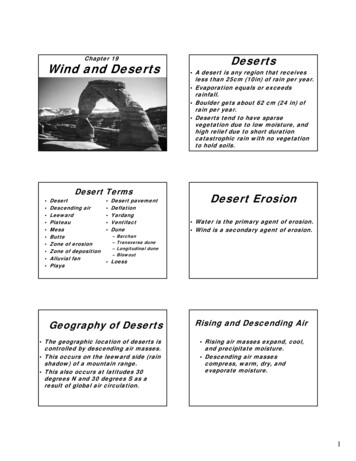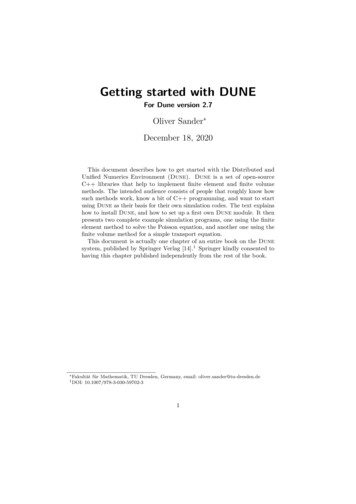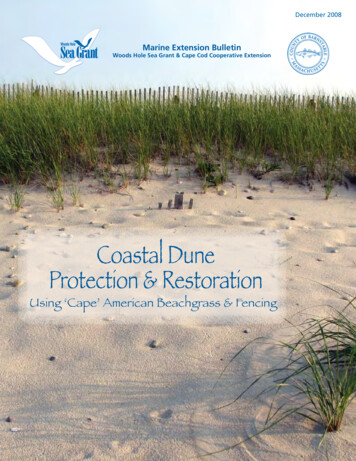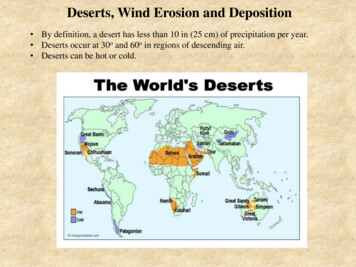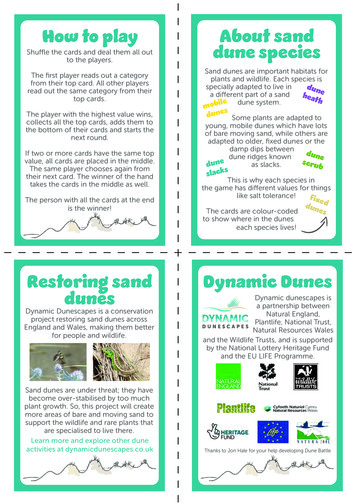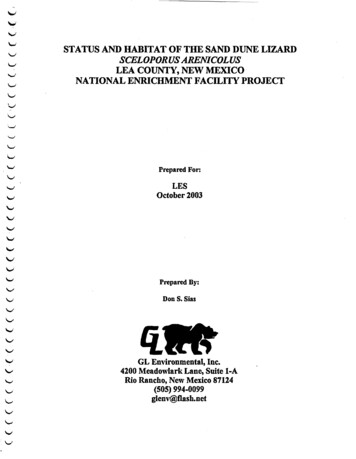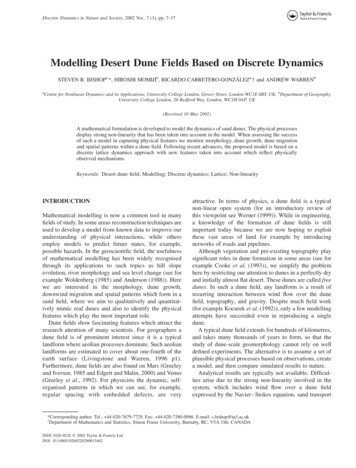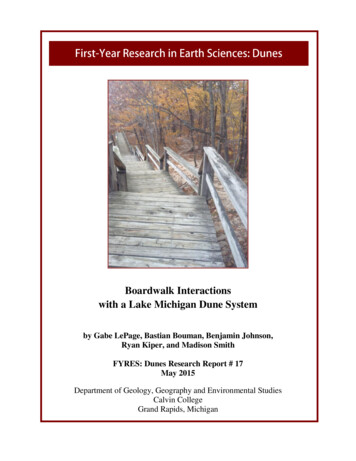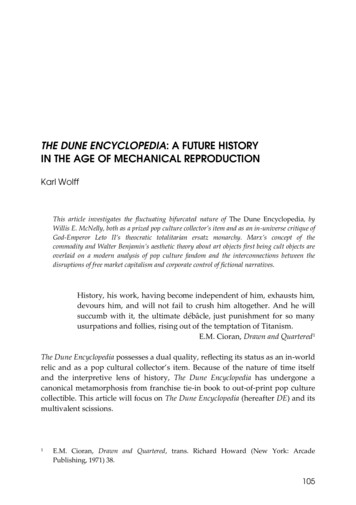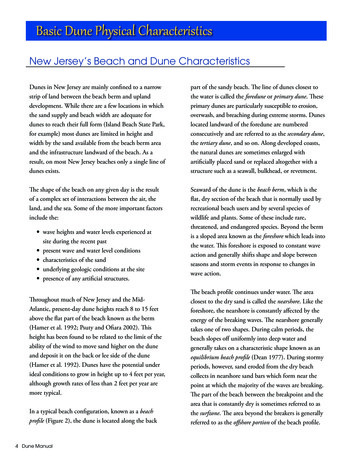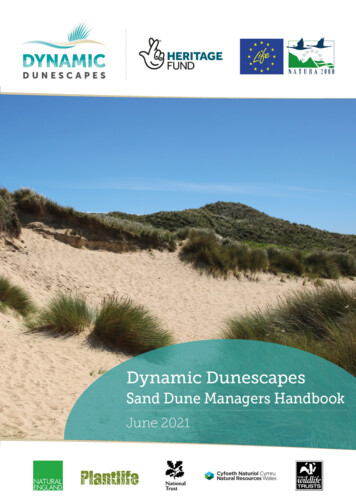
Transcription
1
THE SAND DUNE MANAGERSHANDBOOKProduced by UKCEH, Liverpool Hope University, and Dynamic Dunescapes partners; NaturalEngland, Plantlife, Natural Resources Wales, National Trust and The Wildlife Trusts, with supportfrom the European LIFE programme (LIFE17NAT/UK/000570) and the National Lottery HeritageFund (HG-16-08643).Version 1.0. June 2021How to cite this document:Jones, L.1, Rooney, P.2, Rhymes. J.2 and Dynamic Dunescapes partners (2021). The Sand DuneManagers Handbook. Version 1, June 2021. Produced for the Dynamic Dunescapes (DuneLIFE)project: LIFE17 NAT/UK/000570; HG-16-0864361 UK2Centre for Ecology & HydrologyLiverpool Hope UniversityVersionUpdate history:1.0DateSummary of key changesJune 2021Version 1 published2
Contents1INTRODUCTION . 102Sand, wind, water and plants. 102.1Sand. 102.2Wind . 102.3Water . 112.4Plants. 113Why do we need to manage dunes ? . 124Management techniques past, present and future . 1554.1Past. 154.2Present . 154.3Future . 16Structure of the handbook. 16BEFORE YOU START. Error! Bookmark not defined.67NATURAL DUNE DYNAMICS (Principles) . 176.1Working with natural processes . 176.2Landscape scale. 176.3Management options. 186.4Seek advice. 18DUNE HYDROLOGY (Principles) . 197.1Water tables . 197.2Groundwater chemistry . 197.3Recharge . 197.4Plant communities and succession . 197.5Threats (on and off-site) . 207.6Management levers . 208ENGAGING THE PUBLIC (Principles) . 219MONITORING (Principles) . 239.1Vegetation . 239.2Sand movement . 249.3Hydrology . 253
9.4Soil . 269.5Animals, birds, insects, etc. . 289.6Photo-monitoring. 2810A FEW OTHER TOPICS (Golf courses, forestry, archaeology, unexploded ordnance) . 2910.1Unexploded Ordnance (UXO) . 2910.2Golf courses . 3110.3Forestry on dunes . 3210.4Archaeology . 33QUICK OVERVIEWS . 3411NOTCHING. 3412TURF STRIPPING AND RE-PROFILING . 3513GRAZING. 3614MOWING and CUTTING . 3715SCRUB CLEARANCE. 3816INVASIVE SPECIES CONTROL . 39DETAILED OVERVIEW OF EACH TECHNIQUE . 4017NATURAL DUNE DYNAMICS . 4017.1Goals / targets . 4017.2Benefits . 4017.3Landscape scale. 4217.4Other considerations . 4217.5Management options. 4317.6Monitoring . 4318HYDROLOGICAL MANAGEMENT . 4418.1Water tables . 4418.2Groundwater chemistry . 4518.3Recharge . 4618.4Hydrological guidelines for dune slack vegetation . 4618.5Nutrient regulation . 4818.6Threats to hydrology . 4818.6.1Water abstraction and drainage . 484
18.6.218.7Climate change. 49Management levers . 4918.7.1Ditch management. 4918.7.2Managing abstraction . 4918.7.3Artificial recharge of groundwater. 4918.7.4Forest management . 4918.819Monitoring . 50NOTCHING. 5119.1Goal/Target . 5119.1.1Goal & benefits . 5119.1.2When to use . 5119.2Design considerations . 5119.2.1How to . 5119.2.2Where to locate, and is there a good supply of sand? . 5219.2.3Shape, size and number of notches . 5319.3Other considerations . 5319.3.1Contractors . 5319.3.2In combination with turf stripping . 5319.3.3Coastal flood risk management . 5319.3.4Public perception – key messages . 5319.4Things to watch out for . 5419.4.1May be short lived . 5419.4.2 /- Effects on downwind habitats . 5419.5Nutrients . 5419.6Monitoring . 5419.7Cost . 5519.8Seek advice. 5520TURF STRIPPING AND RE-PROFILING . 5620.1Goal/Target . 5620.1.1Goal & benefits . 5620.1.2When to use . 585
20.2Design considerations . 5820.2.1How to . 5820.2.2Size, bigger is usually better. 5820.2.3Shape (shallow angle of edges creates more habitat) . 5920.2.4To what depth? . 6020.2.5Planning excavation depth for dune slacks. 60Method A - using a reference community in good ecological condition . 61Method B - using hydrological data . 6320.3Other considerations . 6620.3.1What to do with the soil?. 6620.3.2Seedbank and propagules . 6620.3.3Briefing contractors and volunteers . 6620.4Public perception – key messages . 6720.5Things to watch out for . 6720.5.1May be short lived . 6720.5.2 /- Effects on downwind habitats . 6720.5.3Spread of undesirable species . 6720.6Nutrients . 6820.7Monitoring . 6820.8Cost . 6821GRAZING. 6921.1Goal & benefits . 6921.2When to use . 6921.3How to . 6921.3.1Types of Grazers . 6921.3.2Stocking density . 7321.3.3Mob grazing . 7321.3.4An adaptive management approach. 7321.4Other considerations . 7321.4.1Fencing . 7321.4.2Provide water . 756
21.4.3Supplementary feeding . 7521.4.4Stock management . 7521.5In combination with other management . 7521.6Public perceptions – key messages . 7521.7Things to watch out for . 7621.7.1Damage to sensitive species . 7621.7.2Preferential dunging and nutrient inputs . 7621.8Monitoring . 7621.9Cost . 7622MOWING and CUTTING . 7722.1Goal & benefits . 7722.2When to use . 7722.3How to . 7722.3.1Mowing Design . 7822.3.2Mowing Frequency . 7822.3.3Mowing timing . 7822.4Other considerations . 7822.4.1Machinery wear and tear . 7822.4.2Access restrictions. 7822.4.3Disposal of material . 7822.5Things to watch out for . 7922.5.1Sward height can be too uniform . 7922.5.2Damage to dune features . 7922.5.3Spread of competitive species . 7922.6Nutrient removal. 7922.7Relation to other management techniques . 8022.8Monitoring . 8022.9Cost . 8023SCRUB CLEARANCE. 8123.123.1.1Goal/Target . 81Goal & benefits . 817
23.1.223.2When to use . 81Design considerations . 8223.2.1How to . 8223.2.2How much scrub to remove . 8223.2.3Timings . 8323.2.4Preventing regrowth . 8323.3Other considerations . 8323.3.1Other species, other factors . 8323.3.2Maintain dune profiles . 8323.3.3Contractors . 8423.3.4Disposal of plant material . 8423.3.5Removal of enriched soils . 8423.3.6Public perception – key messages . 8523.4Things to watch out for . 8523.4.1Regrowth . 8523.5Nutrients . 8523.6Monitoring . 8523.7Cost . 8524INVASIVE SPECIES CONTROL . 8624.1Goal/Target . 8624.1.1Goal & benefits . 8624.1.2When to use . 8624.2Design considerations . 8724.2.1How to . 8724.2.2Should I try and get rid of all invasive species ? . 8724.3Other considerations . 8824.3.1Contractors . 8824.3.2Disposal of material . 8824.3.3Public perception – key messages . 8824.4Things to watch out for . 8924.5Nutrients . 898
24.6Monitoring . 8924.7Cost . 8925List of case studies . 909
1 INTRODUCTIONCoastal sand dunes are found on coastlines around the world and support a high level ofbiodiversity, including many threatened plant, insect and animal species. These dynamic ecosystemsare shaped by four key elements: sand, wind, water and vegetation. Sand is the basic material dunesare made of; wind speeds need to be fast enough to pick up the sand grains and move them;groundwater near the soil surface is necessary for dune wetlands to form; plants themselves are thefourth agent, which helps create different types of dune. Together, these forces shape dunelandforms and the plant and animals that live in the dune system.Unfortunately, dynamic dune systems with naturally blowing sand no longer occur across most ofthe UK and north-west Europe. Most dune systems now consist of stabilised dune landformscovered in vegetation. This has resulted in loss of habitat and a decline in many rare species.Fortunately, there are a wide range of dune management options available to address these issues.This handbook aims to keep our management techniques up to date for the needs of duneconservation in a variety of situations.2 Sand, wind, water and plantsSand, wind, water and plants are the four major components that influence the dynamics of a sanddune system.2.1 SandCoastal dunes require an adequate supply of sand. Currents, tides and waves all bring sand to thebeach from the sea. From there, the wind blows it inland. The beach acts as a sand store, with sandbeing deposited up the beach in normal conditions, but in storms it can be eroded seawards bywaves. After a storm the eroded sand often forms a sand bar below the low tide level, ready to beslowly moved up the beach again, but in big storms it can also be taken further out to sea and lost tothe beach system. This exchange of sand between the sea and the beach is the first part of thedynamic system.Moving sand is the basis of all dune landforms, whether mobile dunes, blowouts, or forming duneslacks. These are described in the next sections.2.2 WindAt low tide, onshore winds blow sand from the beach into the dunes, but only when wind speeds arefaster than 4 metres per second. This blown sand can become trapped among debris on the upperbeach or between pioneer plant species to create embryo dunes and foredunes. Strong winds canalso carry sand much further inland. Wind is a constant force in dune systems, and because dunesneed wind to form, they are often found along exposed coasts in combination with a good sandsupply. Wind causes lines of dunes to migrate inland (mobile dunes), with sand slowly being blownover the top of a dune and cascading down the other side. In this way, the dune can slowly creepinland, at long term average rates of around 1-2 metres per year. Wind also causes ‘blow-outs’,where a small section of dune starts moving, forming an individual ‘parabolic’ or ‘crescent’ shapeddune, or the wind may begin to excavate a hollow where the turf layer is broken. Dune features tendto be oriented in relation to the dominant winds, but once established they can lead to localvariation in wind direction around individual features. Their orientation can also be quite resistant to10
change, even when there are longer term changes in wind direction. These are natural processes in adynamic dune system, and part of a natural cycle which creates new younger dune habitat.2.3 WaterWater helps shape dune systems in a number of ways. The most obvious is that near the coast, thegroundwater (the water table, which is fresh water) is often near the surface of the dune system.One indication of this is when you can see the groundwater seeping out along the beach at low tide.When the wind is blowi
Wind is a constant force in dune systems, and because dunes need wind to form, they are often found along exposed coasts in combination with a good sand supply. Wind causes lines of dunes to migrate inland (mobile dunes), with sand slowly being blown over the top of a dune and cascading down the other side. In this way, the dune can slowly creep
